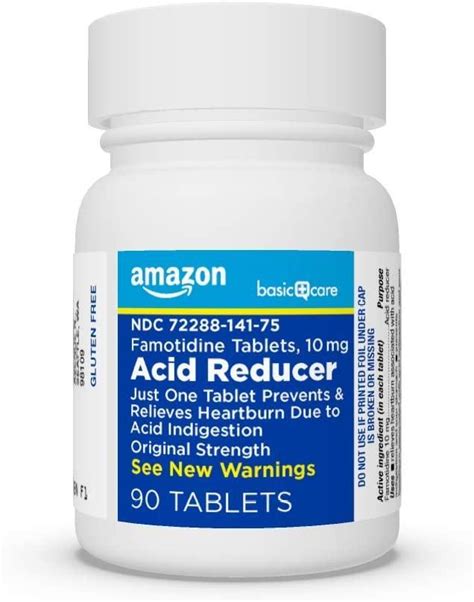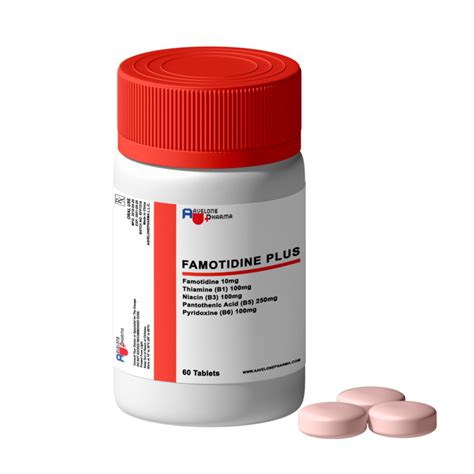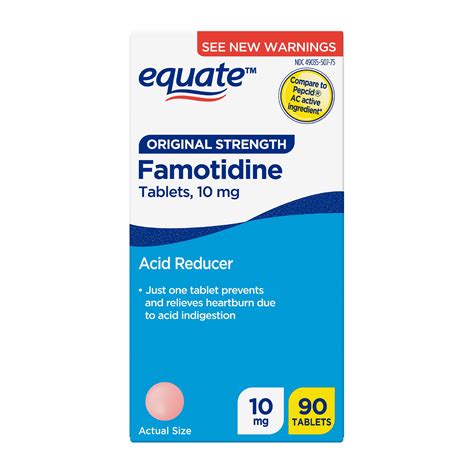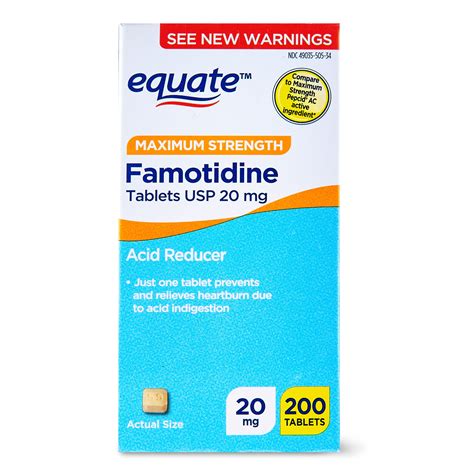Intro
Famotidine treats heartburn, acid reflux, and ulcers, reducing stomach acid with histamine-2 blockers, relieving GERD symptoms.
Famotidine is a medication that has been widely used for several decades to treat various conditions related to the stomach and gastrointestinal tract. Its importance lies in its ability to reduce the production of stomach acid, thereby providing relief from symptoms such as heartburn, acid reflux, and stomach ulcers. The medication works by blocking histamine receptors in the stomach, which are responsible for stimulating acid production. This mechanism of action makes famotidine an effective treatment option for conditions where excessive stomach acid is a primary concern.
The use of famotidine has been well-documented in medical literature, and its efficacy in treating gastrointestinal disorders has been extensively studied. Patients who suffer from conditions like gastroesophageal reflux disease (GERD), Zollinger-Ellison syndrome, and peptic ulcer disease often find relief with famotidine. Moreover, the medication is also used to prevent stomach ulcers in patients who are at risk due to the use of nonsteroidal anti-inflammatory drugs (NSAIDs) or other factors. The versatility of famotidine in addressing a range of gastrointestinal issues has made it a staple in both prescription and over-the-counter (OTC) medication formularies.
Famotidine's application extends beyond the treatment of existing conditions; it is also used as a preventive measure. For instance, individuals who experience frequent heartburn or acid reflux can use famotidine to reduce the occurrence of these symptoms. This proactive approach can significantly improve the quality of life for those who suffer from chronic gastrointestinal issues. Furthermore, the medication's safety profile and minimal side effects make it an attractive option for long-term use, under the guidance of a healthcare provider. With its broad range of applications and proven efficacy, famotidine remains a critical component in the management of stomach and gastrointestinal disorders.
Introduction to Famotidine

Famotidine belongs to a class of medications known as H2 blockers or histamine-2 receptor antagonists. Its chemical structure and pharmacological properties allow it to selectively bind to histamine receptors in the stomach lining, thereby inhibiting the release of gastric acid. This reduction in acid production is key to the medication's therapeutic effects, as excessive stomach acid is a common factor in many gastrointestinal disorders. The introduction of famotidine in the 1980s marked a significant advancement in the treatment of acid-related diseases, offering an alternative to older medications with more side effects.
How Famotidine Works
The mechanism of action of famotidine involves the competitive inhibition of histamine at the H2 receptor sites on the parietal cells in the stomach. Histamine is a natural substance in the body that stimulates the parietal cells to produce gastric acid. By blocking these receptors, famotidine reduces both the basal and stimulated secretion of gastric acid. This effect is dose-dependent, meaning that higher doses of the medication can lead to greater reductions in acid production. The onset of action for famotidine is relatively rapid, with significant reductions in acid secretion observed within an hour of oral administration.Benefits of Using Famotidine

The benefits of using famotidine are multifaceted, ranging from the treatment of acute conditions to the prevention of chronic diseases. Some of the key advantages include:
- Rapid relief from heartburn and acid reflux symptoms
- Effective in healing stomach and duodenal ulcers
- Can prevent the recurrence of ulcers
- Reduces the risk of bleeding from stomach ulcers
- Improves quality of life by reducing symptoms and allowing for a more normal diet and lifestyle
In addition to these benefits, famotidine is generally well-tolerated, with a lower incidence of side effects compared to some other gastrointestinal medications. This safety profile makes it suitable for a wide range of patients, including those with chronic conditions requiring long-term management.
Common Uses of Famotidine
Famotidine is prescribed for several conditions, including: - Gastroesophageal reflux disease (GERD): Characterized by the backflow of stomach acid into the esophagus, leading to symptoms like heartburn and regurgitation. - Peptic ulcer disease: Includes both stomach (gastric) and duodenal ulcers, which are sores that develop on the lining of the stomach or the first part of the small intestine. - Zollinger-Ellison syndrome: A rare disorder that causes the stomach to produce too much acid, leading to severe ulcers. - Prevention of NSAID-induced ulcers: Patients taking nonsteroidal anti-inflammatory drugs for prolonged periods are at an increased risk of developing stomach ulcers, and famotidine can help mitigate this risk.Side Effects and Interactions

While famotidine is considered safe for most people, it can cause side effects in some individuals. Common side effects are usually mild and may include headache, dizziness, constipation, and diarrhea. More serious side effects are rare but can include allergic reactions and changes in liver function tests. It is essential for patients to report any side effects to their healthcare provider, especially if they are severe or persistent.
Famotidine can also interact with other medications, altering their effectiveness or increasing the risk of side effects. For example, it can decrease the absorption of certain drugs like ketoconazole and itraconazole, which are used to treat fungal infections. Patients should inform their healthcare provider about all the medications they are taking, including vitamins and supplements, to minimize the risk of interactions.
Dosage and Administration
The dosage of famotidine varies depending on the condition being treated and the patient's response to the medication. For adults, the typical dose for treating GERD and peptic ulcer disease is 20-40 mg once or twice daily. For Zollinger-Ellison syndrome, higher doses may be required, and the medication is usually administered in a hospital setting. It is crucial to follow the dosage instructions provided by the healthcare provider and to complete the full course of treatment as prescribed, even if symptoms improve before the medication is finished.Over-the-Counter (OTC) Use

Famotidine is available in both prescription and OTC forms. The OTC version is used for the relief of heartburn, acid reflux, and sour stomach. It is essential for individuals using the OTC version to carefully read and follow the label instructions, as the dosage and duration of treatment may differ from the prescription version. OTC famotidine should not be used for more than 14 days without consulting a healthcare provider, as prolonged use without medical supervision can lead to unintended consequences, such as masking symptoms of a more serious condition.
Precautions and Warnings
Before starting famotidine, patients should discuss their medical history with their healthcare provider, especially if they have kidney or liver disease, as these conditions may affect the medication's metabolism and excretion. Pregnant or breastfeeding women should also consult their healthcare provider before using famotidine, as the safety of the medication in these populations has not been extensively studied.Conclusion and Future Directions

In conclusion, famotidine remains a vital medication in the treatment and management of gastrointestinal disorders. Its efficacy, safety profile, and versatility make it a preferred choice for both healthcare providers and patients. As research continues to uncover the complexities of gastrointestinal diseases, the role of famotidine and other H2 blockers will likely evolve, potentially leading to new applications and treatment strategies. For now, famotidine stands as a testament to the advancements in pharmacotherapy, offering relief and improved quality of life to millions of people worldwide.
Final Thoughts
The importance of famotidine in modern medicine cannot be overstated. From its introduction to the present day, this medication has played a critical role in the management of stomach and gastrointestinal disorders. As we look to the future, it is clear that famotidine will continue to be a valuable tool in the treatment of these conditions, providing effective relief and prevention of symptoms for those who need it.What is famotidine used for?
+Famotidine is used to treat and prevent conditions like gastroesophageal reflux disease (GERD), peptic ulcer disease, and Zollinger-Ellison syndrome by reducing stomach acid production.
How does famotidine work?
+Famotidine works by blocking histamine receptors in the stomach, which reduces the production of gastric acid. This action helps in healing ulcers and preventing their recurrence.
What are the common side effects of famotidine?
+Common side effects of famotidine include headache, dizziness, constipation, and diarrhea. More serious side effects are rare but can include allergic reactions and changes in liver function tests.
We invite readers to share their experiences with famotidine or ask questions about its use in the comments below. Your input can help others understand the benefits and potential drawbacks of this medication, contributing to a more informed community. Additionally, consider sharing this article with someone who might benefit from the information, as knowledge is power, especially when it comes to managing our health.
